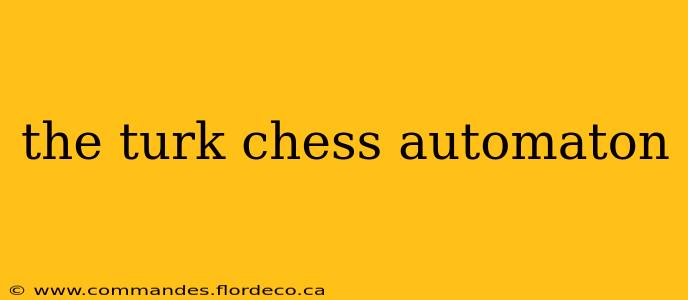The Turk, a celebrated 18th-century automaton, captivated audiences worldwide with its seemingly superhuman ability to play chess. This intricate mechanical marvel wasn't just a clever illusion; it was a complex piece of engineering that sparked debate and fascination for centuries. But what was the Turk truly? Was it a genuine automaton, or a masterful hoax? This article delves deep into the history, mechanics, and legacy of this iconic chess-playing machine.
What was the Turk chess automaton?
The Turk, officially titled "The Automaton Chess Player," was a life-sized figure of a Turk dressed in elaborate clothing, seated behind a chessboard. It was presented as a self-operating machine capable of playing chess against human opponents, often winning convincingly. Its complex movements and seemingly intelligent gameplay mesmerized audiences from Europe to the Americas. However, its true nature was a closely guarded secret, one that wouldn't be fully revealed until many years after its demise.
How did the Turk chess automaton work?
The Turk's operation wasn't based on genuine artificial intelligence, as we understand it today. Instead, it relied on a sophisticated system of hidden compartments and a human operator. A skilled chess player, concealed within the machine's internal structure, would manipulate the pieces using a complex system of levers and magnets. The operator's movements were cleverly masked by the Turk's elaborate costume and the internal mechanisms.
Who invented the Turk chess automaton?
The Turk was the creation of Wolfgang von Kempelen, a Hungarian inventor, in 1769. Von Kempelen presented it to Empress Maria Theresa of Austria, showcasing its seemingly impossible abilities. After von Kempelen's death, ownership of the Turk changed hands several times, eventually finding its way to the renowned showman, Jean-Nepomucène Maelzel. Maelzel extensively toured the automaton, significantly enhancing its fame and mystique.
Was the Turk a real automaton?
No, the Turk was not a real automaton in the sense of a self-operating machine with artificial intelligence. Its ability to play chess was entirely dependent on a concealed human operator. The mechanical complexity served as a masterful deception, masking the operator's presence and actions. The illusion was so effective that many onlookers and even expert chess players remained convinced of the machine's independent capabilities.
How was the operator hidden inside the Turk?
The operator's hiding place was cleverly concealed within the machine's intricate structure. This space was designed to be cramped, requiring considerable dexterity and skill from the operator. The operator would sit inside a small, hidden compartment and operate levers and magnets using their feet and hands. The ingenious design allowed for plausible, albeit somewhat jerky, movements of the mechanical arm which manipulated the chess pieces.
What happened to the Turk chess automaton?
After a long and successful career touring the world, the Turk's final days were marked by several misfortunes. Eventually, it was destroyed by a fire in 1854, losing its secrets to the flames. However, its legacy lives on, both as a remarkable piece of engineering and a reminder of the fascinating interplay between technology, illusion, and public perception.
What is the legacy of the Turk chess automaton?
The Turk's legacy extends far beyond its ingenious mechanism. It represents a significant point in the history of automatons and artificial intelligence. It sparked widespread public fascination with the idea of machines capable of human-level intelligence, inspiring countless inventors and artists to explore the possibilities of artificial intelligence. The Turk's story continues to be re-told, reminding us of the enduring power of both illusion and ingenuity.
The Turk's enduring appeal: a symbol of technological ambition
The Turk, while ultimately a cleverly engineered illusion, stands as a testament to human creativity and the enduring fascination with artificial intelligence. It continues to capture imaginations, highlighting the ongoing quest to create truly intelligent machines. Its intricate mechanisms and masterful deception continue to inspire awe and wonder, securing its place in history as more than just a chess-playing automaton; it's a symbol of our persistent ambition to push the boundaries of technology.
